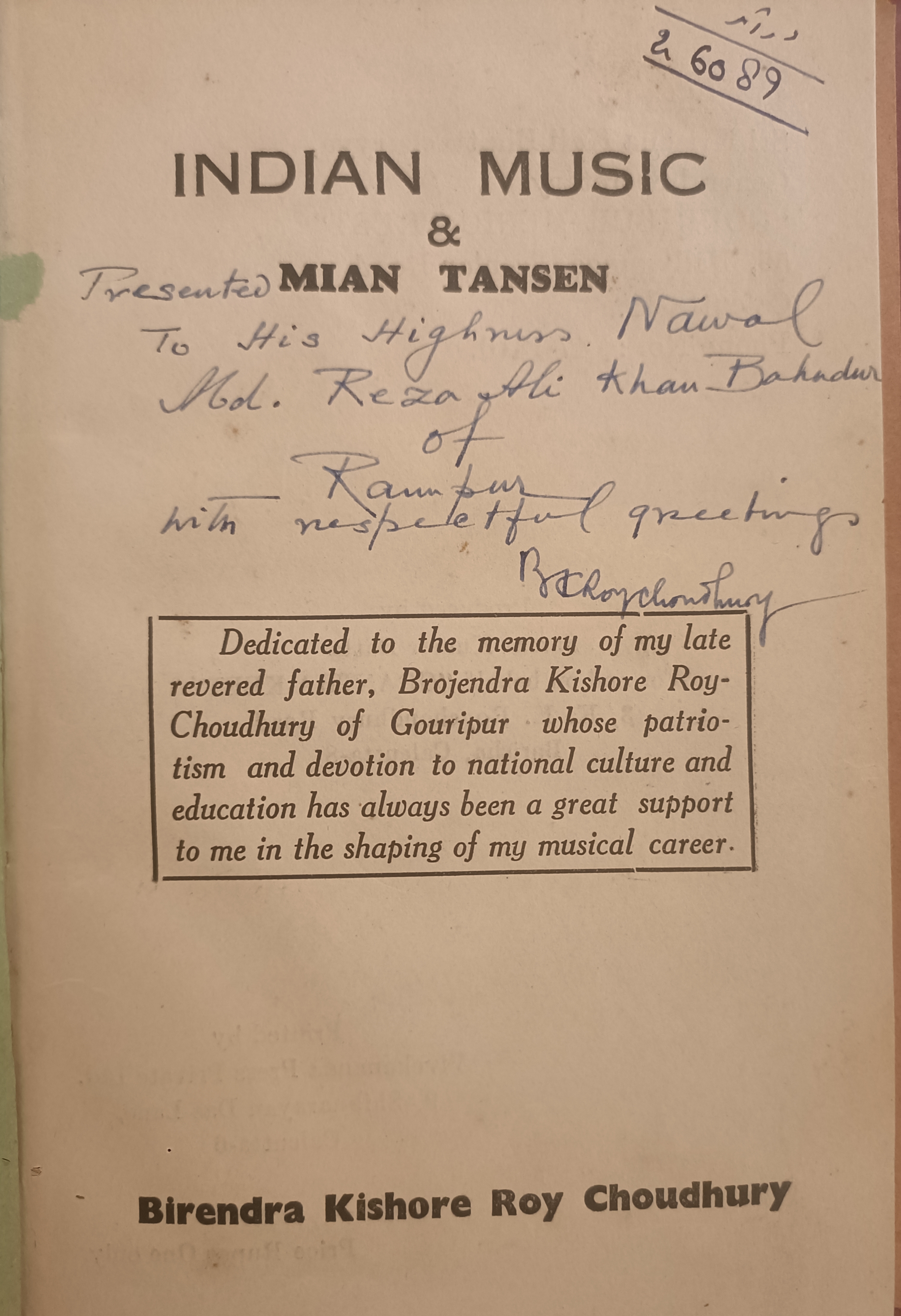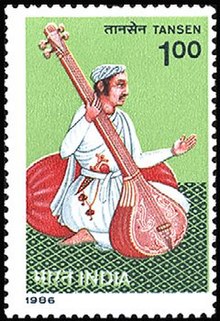.webp)
Sanam Ali Khan
The Rampur Raza library contains a rare book ‘Indian music and Mian Tansen’ written by Pandit Birendra Kishore Roy Choudhury (1901-1972) and self-published in 1959. The author presented it with a handwritten note to the last Nawab Raza Ali Khan. The small book investigates into the origins and development of Indian classical music and the contributions of artists and their lineages.
This book also sheds light on the Tansen School of Music at a time when two luminaries from Tansen’s gharana - veena player Mohd Wazir Khan, the guru of Nawab of Rampur state, and Pandit Bhatkhande and Rabab player Mohammad Ali Khan, who was in the court of Rampur and the guru of Nawab Chhamman sahib, were on the scene. Nawab Chhamman Sahib was a colleague of Wazir Khan and excelled in dhrupads and sursringar genres.
An interesting note of blessings from Dr. S.N. Ratanjankar (1900-1974) Padmabhushan praises the author as an impressive practical demonstrator of the Hindustani Ragas on veena and sursringar. He addresses him as a well-read man in musical literature and one who is considered an authority on music. The author was trained by Ustad Mohammad Ali Khan of Rampur and Dabir Khan Sahib. Both were the descendants of the Tansen family.
Sangeet Nayak Wazir Khan, the mentor of the maestro's Baba Allauddin Khan, Mushtaque Hussain Khan, and Hafez Ali Khan. Ustad Wazir Khan was not just a musician but also a musicologist. He wrote 'Risala Mousiqi,' a comprehensive work complete with notations. He was the head of Arbab e-nishat (music department) in Rampur State during the time of Nawab Hamid Ali Khan.
Pandit Bhatkhandeji also received training in Indian classical music from Wazir Khan. He is remembered in the history of Indian music because of his endeavor to rebuild Indian music from the rubble of the first disintegration of the princely courts in India. Not only did he set up schools and colleges for the propagation of classical music, but he also set up many well-known gharana. The musicians in these institutions saved many musicians from falling into poverty. Due to his sincerity, he inspired the ruling princely states including the Nawab Rampur.
 The handwritten note by Birendra Kishore Roy Choudhary
The handwritten note by Birendra Kishore Roy Choudhary
After the end of the sepoy mutiny in 1859 Nawab Wajid Ali Shah, the patron of classical music settled in Calcutta. He brought eminent musicians like Basat Khan, Kasem Ali Mian of the Tansen line, Murad Khan, and Taj Khan along with some exceptional Kheyal singers from Lucknow to Kolkata. Among the other stalwarts from the Tanseni line, Sadeque Ali Khan, a Rabab player and a researcher settled at Benaras. He trained religious singers like Mithailallji and Bajpayeji and soon Benaras became a centre of classical music.
Rampur Gharana was the last of the topmost Musical Gharanas of India set up by the Pathans of Rohilkhand during the rule of Nawab Yusuf Ali Khan. Rampur emerged as a prominent center for North-Indian classical music. The two gems of Hindustani music named Bahadur Hussain Khan, Sursringar player, and Amir Khan (son of Umrao Khan Seni renowned Veena player) were welcomed and given due regard and promise of princely allowances by Nawab Kalbe Ali Khan of Rampur state. Portrait paintings of Bahadur Hussain Khan and Amir Khan were featured in the illustrated Manuscript MusaddasTahniyat-e-Jahsn-e-Benazir written by Mir Yar Ali Jan (1810-1886)
Bahadur Hussain Khan was glorified for his enchanting style of playing that people used to wonder if his fingers were made of diamonds. Bahadur Hussain Khan brought in a variety of new Alankaras (embellishments) in instrumental music, including unique variations of Jhala or Jhankar that have yet to be matched by any other Indian instrumentalist playing the Sitar or Sarod. The two musicians were notable dhrupada singers of the Tansen line captivating both classical music enthusiasts and casual listeners, thus solidifying Rampur as a significant hub for Hindustani classical music.
Veen player Amir Khan had a melodious voice, and although he was originally an instrumentalist, he focused on vocal music. He rarely played Veena in Rampur Durbar in front of Bahadur Hussain Khan, who happened to be his uncle-in-law. However, he sang vocal alap, dhrupads and dhamars in the durbar. During this period, classical ‘Thumri’ was created by the famous composers Kadar Piya, Sadar Piya, and Sanada Piya of the Lucknow court during the reign of Wajid Ali Shah.
As the Nawab set out from Lucknow for Calcutta and the Lucknow Darbar was dissolved, Sanada Piya accompanied Bahadur Hussain and Aamir Khan to Rampur. Sanada Piya's voice was like that of "Cuckoo" and his Thumri style was very charming. But Amir Khan sang Dhamar in such a way that the charisma of his voice and style overwhelmed Thumri's best examples.
 Postal Stamp on Miyan tansen released by Indian Post
Postal Stamp on Miyan tansen released by Indian Post
The unique charms of the Rampur Gharana, founded by Bahadur Hussain and Amir Khan, included special techniques in Alap, Dhrupad, Dhamar, and instrumental music that set them apart from other music schools in India. These great musicians passed on their knowledge to Nawab Haidar Ali Khan, the brother of Nawab Kalbe Ali Khan, who became a renowned musician in both vocal and instrumental music. Under Haidar Ali Khan, Rampur State saw a rise of talented musicians who became disciples of Bahadur Hussain and Amir Khan, incorporating the distinctive style of the Rampur Gharana. Bahadur Hussain also composed many Taranas, which were performed by khayal singers of Rampur State.
The royal courts of Rampur and Jaipur respected and cared for Mian Tansen's descendants and adhered to Tanseni teachings. The Nkhayalawabs of Rampur were known for their deep appreciation of music. The late Nawabs Haidar Ali Khan, Hamid Ali Khan, and Chhaman Saheb were skilled in both vocal and instrumental music. Nawab Chhamman Saheb also authored significant manuscripts such as 'Risala Tansen' and 'Nurul Hawdayak', focusing on the philosophy of music. These valuable writings are carefully preserved in the Rampur Raza Library and Museum.
The writer of the book Birendra Kishore Roy Choudhury mentions in one of the chapters that Tansen formulated his music theories based on the Shiva Mata and the Hanuman Mata, which detailed the characteristics of the six main Ragas - Bhairav, Malkos, Hindol, Shree, Megh, and Dipak - along with their Raginis and Raga Putras. In works like Sangitadarpana, the correlation between Ragas and Raginis appears to be based on imagination. Basat Khan and Wazir Khan, however, rearranged these relationships in their musical manuscripts according to Tansen's theories, creating a harmonious blend of logic and tradition.
During the rule of Emperor Akbar, Mian Tanser, a disciple of Swami Haridas of Vrindaban and Swami Ramdas of Avadh and a foster child of Pir Mohd Ghaus of Gwalior, was renowned as the greatest musician of his time. He led a musical revolution, with disciples of other Nayaks flocking to learn from him. His Alap and Dhrubapada techniques were considered the finest, enriched with Persian influences. Tansen combined philosophical principles and practices from the Vedas, Bhakti Shastra, and Sufi cults of India with Persian music. The songs he composed attest to his true love for the Gods and Avatars as well as for Prophet Muhammad (PBUH).
Regarding the Middle Eastern musical tradition that inspired Tansen, we find the following account in the manuscripts of Wazir Khan. About the origin, history or legend of music, the ancient Persians believed that this art originated from the melodic tones of a bird they called ‘Mausiqar’ there are seven holes in the bird's beak and different sounds emitted from each hole. This ultimately led to the creation of seven basic notes.
Thus Wazir Khan and Chhamman Saheb were the successors in the line of music of Amir Khan and Bahadur Hussain. Wazir Khan by musical teachings built up the musical career of the following outstanding musicians.
Allauddin Khan (Sarod), Hafiz Ali Khan (Sarod), Mehdi Husssain Khan (Dhrupad & Kheyal), Mustaque Hussain Khan (Kheyal), Pramathanath Bandopadhya, (Ruddraveen), Jadabendra Mahapatra (Surbahar), Pandit Bhatkhandeji (The great Musicologist).
Nawab Chhamman Saheb also gave lessons to Pandit Bhatkhandeji among the nawab's other disciples. We may cite the names of Raja nawab Ali Khan of Lucknow (sitar) and Girija Shankar Chakravarthy of Bengal (dhrupada, kheyal and Thumri)
ALSO READ: In Jammu, Thakur Baldev Singh carries on 100-year tradition of hosting iftar
Finally, we shouldn't fail to remember the way that the Bhatkhande School of Music established in 1926 in Lucknow, got colossal help from Nawab Hamid Ali Khan of Rampur, and Nawab Chhamman Sahib, who helped this extraordinary foundation both monetarily and with the valuable musical teachings of the Rampur Gharana.
The author is an art conservationist with the Rampur Library and Museum
